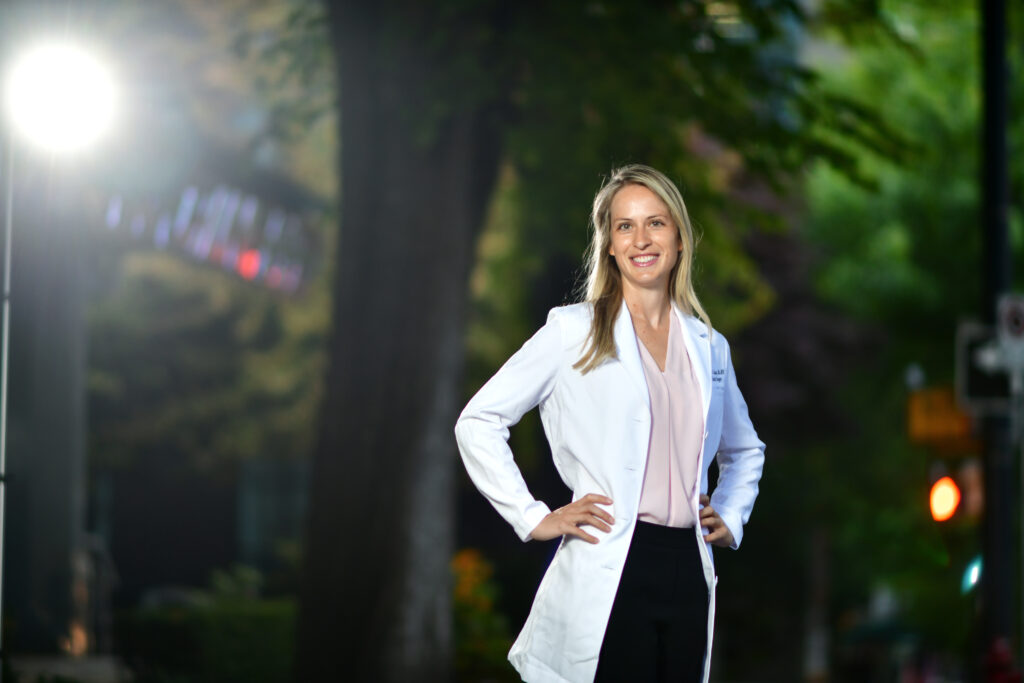Plastic and Reconstructive Surgeon, Vancouver Coastal Health & Providence Health Care
Assistant Professor, University of British Columbia, Canada
P. Clugston Chair of Breast Reconstruction


Chair of Breast Reconstruction, University of British Columbia
Plastic and Reconstructive Surgeon, Vancouver Coastal Health & Providence Health Care
Assistant Professor, University of British Columbia, Canada
P. Clugston Chair of Breast Reconstruction

Select Translate, Highlight the text you would like spoken and it’ll read it aloud for you
I am incredibly proud to champion the betterment of breast reconstruction, as part of comprehensive breast cancer care, in BC and in Canada.
Studies show that emotional, social and functional well-being, vitality, body image and general mental health are improved in women who have breast reconstruction surgery after their mastectomy. The current journey to physical and emotional recovery for women with breast cancer is difficult in its own right and navigating a multi-layer breast cancer treatment system can prove to be an additional challenge.
As Chair, my mission is to enable timely and equitable access of high-quality, personalized care to breast cancer patients desiring reconstruction. To achieve this mission, we will partner with patients, healthcare providers, administrators, and government bodies. The Chair program is founded on clinical research in five domains: analysis of system and processes, optimization of centralized care, application of outcomes research, development of patient-oriented research, and support of translational research.
Kathryn
Breast Reconstruction
Breast reconstruction is an option for women undergoing a partial (lumpectomy) or total mastectomy. Reconstruction of the breast aims to recreate the shape, feel, and appearance of the breast. Women who choose to have reconstruction do so for many reasons. It is a personal decision. Reasons may include a feeling of being whole, a restoration of self, return to a sense of normal, emotional healing, avoiding the mastectomy scar/appearance, and/or avoiding an external prosthesis.
There are many options for breast reconstruction. In broad terms, the whole or partial breast can be reconstructed with implants, your own tissue, or a combination of these. Reconstruction can begin at the time of the mastectomy/lumpectomy, defined as immediate, or can occur after your cancer treatment, defined as delayed.
The recommended method of breast reconstruction depends on a number of factors and these will be discussed with you. During your appointment, we review your breast cancer diagnosis, your goals, your health, your body, and discuss the type of reconstruction that would best be suited to you. With the options available to you, we review the details of the surgical procedures, recovery, risks, benefits, and alternatives. The preservation of the nipple and /or areola, as well as scars, depend on your cancer, your breast size, and your overall health.
Questions to consider before and during your consultation:
Breast Reconstruction using Implants
Implant-based breast reconstruction is one option for reconstructing the shape and size of your breast after cancer. There are two common types of implants used for breast reconstruction. Both are made of an outer silicone shell. Implants can contain sterile salt water (saline implants) or silicone gel (silicone implants).
For implant-based reconstruction, you may be able to have reconstruction at the same time as your cancer surgery (immediate) or at a later date after you complete your cancer treatments (delayed).
The implant will be placed under or over the chest muscle (pectoralis muscle) with a tissue matrix as a sling to hold the prosthesis and optimize the shape of the breast (acellular dermal matrix).
For immediate reconstruction, you may have the reconstruction in stages (two planned operations) or in one stage (one operation).
In one-stage immediate reconstruction with implants (direct-to-implant), the implant is placed at the same time as the breast cancer removal. This option will be discussed if available / recommended for you.
In staged immediate reconstruction, a temporary inflatable balloon (tissue expander) is placed to save the breast skin and mimic the shape of the breast at the first stage. The tissue expander is filled in the office during your recovery, starting approximately 2 weeks after surgery. Once you have reached the desired breast volume and completed necessary other treatments, the tissue expander is exchanged for the permanent implant in a second operation.
There are short term and long term risks associated with implants. Risks related to implants will be discussed with you. These risks include future revision surgery, implant rupture, abnormal scar tissue formation (capsular contracture), implications for imaging, and the rare occurrence of anaplastic large cell lymphoma (ALCL) and Breast Implant Illness (BII). Implications for monitoring your long-term breast health will also be discussed.
Breast Reconstruction using your own Tissue
Tissue-based breast reconstruction is another option for reconstructing your breast where tissue from other parts of the body is transferred to the breast. The tissue transferred is called a “flap” and this flap will include skin and fat. It may or may not also include part or all of a muscle.
There are two common areas of the body where tissue is available to be used for breast reconstruction: the abdomen (tummy) and the back. The abdomen tissue can be transferred as a flap without muscle (the DIEP flap) or can be transferred with some or all of the rectus abdominis muscle (the TRAM flap). The back tissue can be transferred as a flap without muscle (the TDAP flap) or can be transferred with some or all of the latissimus dorsi muscle (the LatDorsi flap). There are other parts of the body that can also be used for transfer of tissue and these will be discussed with you if suited to your situation.
For tissue-based reconstruction, you may be able to have reconstruction at the same time as your cancer surgery (immediate) or at a later date after you complete your cancer treatments (delayed).
For immediate reconstruction, you may have the reconstruction in stages (two planned operations) or in one stage (one operation).
In one-stage immediate reconstruction with your own tissue, the tissue is transferred at the same time as the breast cancer removal. This option will be discussed if available / recommended for you.
In staged immediate reconstruction, a temporary inflatable balloon (tissue expander) is placed to save the breast skin and mimic the shape of the breast at the first stage. The tissue expander is filled in the office during your recovery, starting approximately 2 weeks after surgery. Once you have reached the desired breast volume and completed necessary other treatments, the tissue expander is exchanged for your own tissue in a second operation.
There are short-term and long-term risks associated with tissue-based reconstruction. Risks related to using your own tissue will be discussed with you as these are variable based on the flap chosen. In the short-term, risks include difficulties healing in the area of the body where the tissue is taken. There are also risks related to the survival of the flap. Implications for monitoring your long-term breast health will also be discussed.
Oncoplastic Surgery
Oncoplastic reconstruction is an option for reconstructing your breast after part of the breast is removed. This is for women who are having a partial mastectomy (lumpectomy) and are at risk of a troublesome deformity.
Your surgical oncologist (general surgeon) will refer you to a plastic surgeon if your breast is at risk of being deformed after tumor removal with the partial mastectomy (lumpectomy). This is more common when the tumor is large relative to your breast size or when the tumor is located in a part of the breast that is at higher risk for deformity.
Oncoplastic reconstruction involves either 1) rearranging the remaining breast tissue and skin to improve the shape of a smaller breast or 2) adding tissue from the chest or back to restore the size and shape of the breast after the tumor is removed. The other breast, which does not have cancer, can also be altered to improve the symmetry (in shape and size) of the breasts.
For oncoplastic reconstruction, you may be able to have reconstruction at the same time as your cancer surgery (immediate) or at a later date after you complete your cancer treatments (delayed).
For immediate oncoplastic reconstruction, the remaining breast tissue and skin is reshaped or restored at the same time as the breast cancer removal. This option will be discussed if available / recommended for you.
For delayed oncoplastic reconstruction, the breast is reshaped or restored after you have had the tumor removed and completed any other treatments (such as radiation).
What to Expect for your recovery
Whether you are having reconstruction with an implant or your own tissue, you can expect a recovery that will require 6 weeks of modifications to your normal life and may or may not include a stay in the hospital.
Modifications for 6 weeks include: 1) no lifting more than 5-10 lbs; 2) wearing a compression bra; 3) gradual increase in the range of motion of your arm(s); 4) gradual return to exercise.
Both implant and tissue-based reconstruction require the temporary use of JP drains. These are drains that are placed in the breast (and other parts of body if tissue is transferred) to remove excess fluid that your body is expected to produce after surgery. JP drains are temporary drainage tubes that are placed during your surgery and removed in the office during your follow-up. You will be taught how to monitor and care for the JP drains.
You can also expect to care for your incisions (scars) and JP drains with daily dressings for a period of time (dependent on your reconstruction). Daily dressings usually require an ointment and covering with bandage/gauze/medical tape.
Specific modifications and instructions on dressings will be provided to you based on your chosen reconstruction.
Dr. Kathryn Isaac is the inaugural Dr. Patricia Clugston Chair of Breast Reconstruction at the University of British Columbia, leading system-level changes to improve the delivery of patient-centered care through clinical research.
As an academic plastic and reconstructive surgeon and clinical researcher, I have been enhancing the breast cancer patient journey with the strategic application of health technology, machine learning, and outcomes research to optimize value in health care in the province of British Columbia, Canada.
Clinical Office
Assistant: Priscilla Ting
Diamond Health Care Centre
2775 Laurel Street
Vancouver, British Columbia
Postal code: V5Z 1M9
Phone 604-336-9488. Fax 604-336-9489
Office email kisaac.office@gmail.com
Select Language, Highlight the text you would like spoken and it’ll read it aloud for you
.
‘The true sign of intelligence is not knowledge but imagination.’ – Albert Einstein
‘Pure mathematics is, in its way, the poetry of logical ideas.’ – Albert Einstein.
.
Medical Journal Publications
Dr. Kathryn Isaac : https://www.researchgate.net/scientific-contributions/Kathryn-V-Isaac-2196804463
.
Mathematical Biology Publications
Dr. Leah Edelstein-Keshet
https://www.researchgate.net/search/publication?q=Leah+Edelstein-Keshet
Models for implant-induced capsular contracture post breast cancer surgery
https://link.springer.com/content/pdf/10.1007/s11538-023-01236-2.pdf
Mechanical Model for the Failure of Reconstructive Breast Implant Surgery Due to Capsular Contracture
https://arxiv.org/abs/2411.10569
.
.

Knowledge is power
Knowledge is power ! Download the Perplexity AI app to better understand our content. It synthesizes answers using large language models, real-time web searches and cited sources.
www.perplexity.ai
.
.

‘Look deep into nature, and then you will understand everything better.’ – Albert Einstein
.
.
.